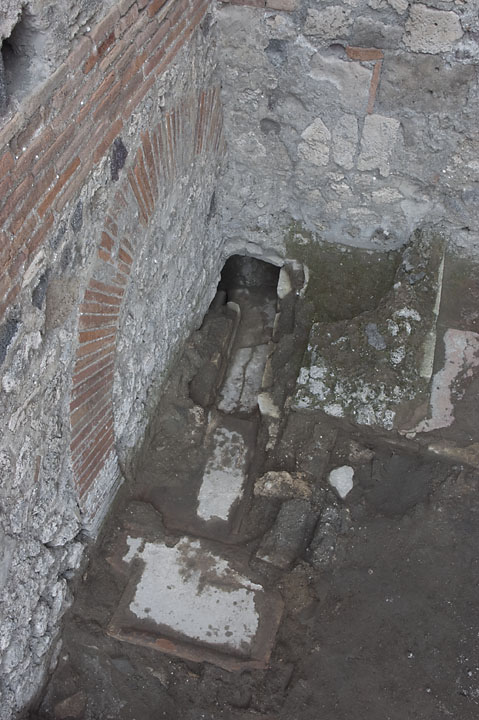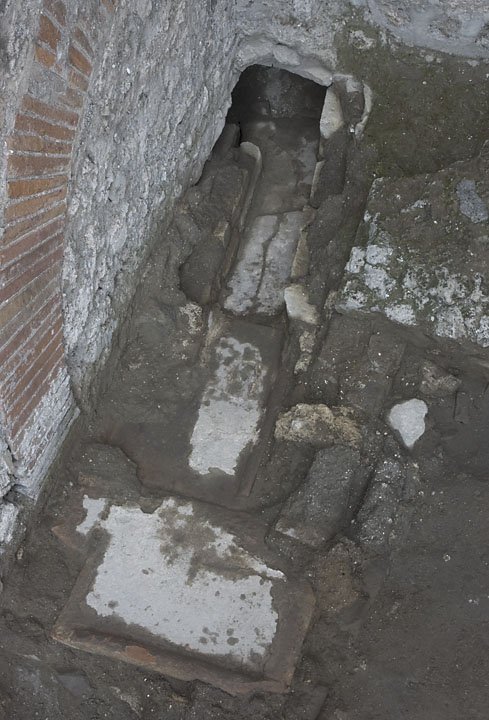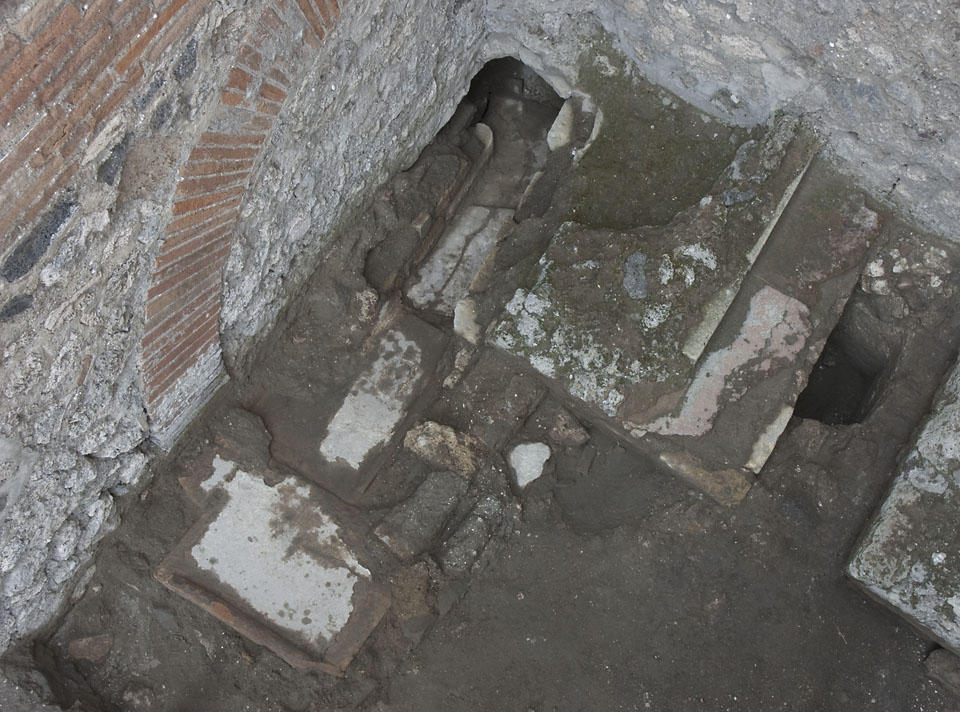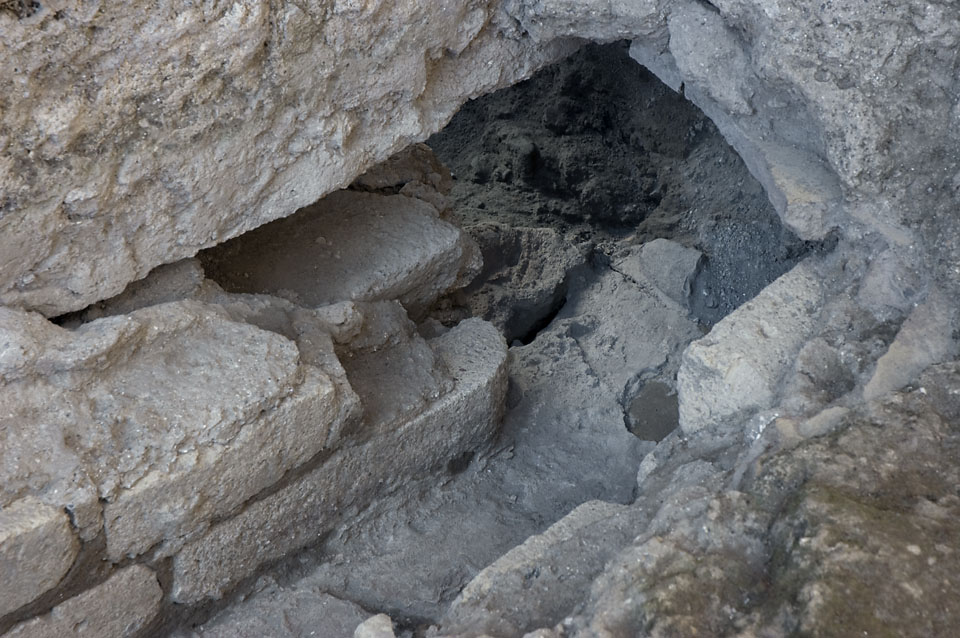Installations in floor
Description
Susanna Blåndman
Drain
The northwest corner of room 5 is dominated by a large drain where five roof tiles constitute the bottom. The drain, with a height of the fall being 0.43 m, is first sloping towards the north and then it turns to the west below the corner of the west and north walls. No covering was found, except for in the northernmost part where a roof tile is placed between the bottom of the wall and the drain. In the west wall, the arch relieves the pressure from the wall. The southernmost part of the drain is located at a distance of 2.48 m from the north wall. The width of the channel is 0.25 m.
The northern part of the drain has sides made of tufa blocks. In the west side five blocks are visible in two courses. The blocks are 0.07 - 0.09 m thick and 0.07 - 0.42 m long. Traces in the mortar reveal a third course and that blocks in the second course are missing. In the east side nine blocks of tufa are visible in three courses and traces in the mortar reveal that a few blocks are missing. The blocks are 0.05 - 0.09 m thick and 0.07 - 0.27 m long.The mortar is brownish.
The southern half of the drain has no sides today, except for a few stones on the east side, but clearly it must have been some kind of delimitation when the drain was in use, otherwise the water would have run outside the drain. The two southernmost roof tiles are encircled by a fragile brownish mortar with an uneven surface and scarce remains of a rim at the east and south sides. Most probably this was a delimitation made of stones and mortar around the upper part of the drain. How high it was is impossible to say but it was 0.10 - 0.20 m wide.
The bottom of the drain is partly covered by a very hard and thin layer of whitish sediment. The layer is 0.005 m thick. At the northwest corner of the fourth roof tile from the south, the sediment layer is 0.015 m thick. There is almost no sediment at the northeast part of the tile, meaning that the water must have flown towards northwest. It is suggested by Flohr (2011, 4-5 and 2013, 103) to be 'Fuller's earth'.
Room 6 in the neighbouring taberna, V 1,1.32, was cleaned and we were able to see that the drain continued into this taberna. There was a layer of hardened ash next to the lowermost roof tile at the bottom of the drain. A couple of bones in the ash were left in situ.
Cistern
A cistern is located at a distance of 0.24 m from the north wall and 1.44 m from the west wall. The space between the cistern and the wall is filled with Sarno stones, a few lava stones, a few fragments of terracotta and a cocciopestospolium; and to some part covered by brownish mortar. A fragmentary patch of supporting plaster on the wall shows that this structure abuts on the wall. To the west the opening of the cistern is delimited by a feature of unclear function. (Flohr 2011, 4. Flohr suggest that this feature is the landing of a staircase), It was not possible to decide if the feature above the cistern is built at the same time or as a later addition.
The cistern is rectangular with slightly rounded corners. The inside is covered with hydraulic plaster containing a large amount of crushed terracotta. The plaster is heavily worn in the upper part. The upper part of the cistern was filled with a modern filling layer, but at the depth of 0.21 m there was a 0.21 m thick layer of wall plaster, containing more than 100 pieces mixed with decomposed plaster. Underneath was a 0.28 m thick layer of hydraulic plaster. The next layer consisted of lapilli. This layer of lapilli continued at least 0.30 m downwards.We were not able to reach the bottom and stopped excavating after 0.74 m; the depth of the cistern is at least 1.00 m. The cistern has an opening in the inner northwest side, at the depth of 0.29 m. The opening is approximately 0.15 x 0.15 m wide.
The area between the drain and the cistern
Between the drain and the cistern is a feature consisting of several different materials and levels. Its function is yet unclear. The feature abuts on the north wall. As mentioned before, the opening of the cistern is partly covered by the east part of this construction. The east part resembles two steps. It consists of overlapping courses of tufa blocks and blocks of Sarno stone. Two roof tiles, partly damaged, form a larger flat area between the courses. This east part measures 1.08 x 0.30 m. The upper surface of the uppermost courses is covered by a 0.12 m thick layer of mortar and stones. The mortar is brownish.
The west part of the area between the drain and the cistern is built entirely in mortar and stones . What kind of stones is difficult to see due to the amount of mortar, but a couple of lava stones and a few Sarno stones are visible. It was also difficult to see the colour of the mortar due to the constant humidity and the amount of moss covering the feature. The feature has an elevated area in the south part and along the east side. This elevated area is up to 0.23 m higher than the northwest area. Traces in the mortar show that several stones are missing in the elevated area. The corresponding section in the north wall is damaged due to a breach made by tunnellers and most probably this construction was damaged at the same time. The construction abuts on the east side of the drain and its function remains unclear.
The northeast corner
This feature, which abuts on the east and north walls, was visible before the excavation. At first sight it looks like a single rectangular block of stone but it turned out to have several different components. The greater part of the feature consists of a block of Sarno stone with a concave east side. This block measures 0.94 x 0.57 m at most. In the north half the space between the east wall and the block is filled with at least eight tufa stones and a few fragments of terracotta. To the south the upper surface is covered by mortar at an approximately 0.30 x 0.40 m large area. It was difficult to see the colour of the mortar due to the constant humidity and the amount of moss covering the feature.
The two visible sides of the block have patches of greyish mortar on the south and the west side The patch on the south side measures 0.50 x 0.05 m and the patch on the west side measures 0.42 x 0.05 m.
On the south side there is also a patch of mortar sloping against the floor surface. A fragmentary surface of cocciopesto abuts on this patch.
The southwest corner of the block rests on a tufa stone and the northwest side rests on a layer of filling material consisting of soil and stones. This so called foundation is 0.15 m thick. It is not possible to see what the southeast corner rests on but between the tufa stone in the southwest corner and the patch of mortar there is a hole, 0.23 m deep and 0.05 x 0.07 m wide.The function of the feature remains unclear.
Small basin?
Immediately adjacent to the three fulling stalls in room 3 is a feature, made of Sarno stones, lava stones and mortar, which could be what is left of a yet another basin . Unlike the fulling stalls this one would have had its bottom above the floor surface. The basin is almost rectangular in shape and the inner part is concave and has a smooth surface made of mortar. Today it is 0.16 m deep. It was difficult to see the colour of the mortar due to the constant humidity. The feature has a rim at the north and the east sides. To the west it is demarcated by the west wall. To the south stones are missing in the rim but it is clear that the basin abuts on the north fulling stall in room 3. The basin was originally probably higher since it looks like stones are missing in the rim. Flohr concludes that it could have been a basin but that it not is certain (Flohr 2011, 3).
Lava block
An almost rectangular lava block is located adjacent to the east wall, at a distance of 2.68 m from the northeast corner. The surface is flat and the stone is 0.10 m thick. The block rests on a foundation, which is slightly larger than the stone at the north and west sides. The foundation is made of grey mortar, which contains a small amount of lava grains and stones. The corner of the north wall in room 3 and the east wall in room 5 is placed on a block of Sarno stone and that block abuts on the foundation of this lava block. Its function is unclear.
Drain:
L: 0.40 m (N); 0.80 m (S); 2.40 m (W) and 2.48 m (E)
Elevations:
Southernmost roof tile: 32.44 m.a.s.l. Bottom northwest corner: 32.01 m.a.s.l.
Cistern:
Visible opening: 0.42 m (N - S); 0.26 m (W - E).
Total opening: 0.42 m (N - S); 0.50 m (W - E)
Elevation: rim 32.42 m.a.s.l.
Area between the drain and the cistern
East part:L: 1.10 m (N - S); Wi: 0.30 m (W - E)
West part: L: 0.80 m (N); 0.62 m (S); 1.10 m (W); 1.10 m (E)
Elevations:
The east part resembling two steps: 32.55 m.a.s.l and 32.67 m.a.s.l.
Elevated area in the south part: 32.75 m.a.s.l.
Northwest part: 32.52 m.a.s.l.
The northeast corner:
L: 0.60 m (N); 0.58 m (S); 1.10 m (W) and 1.10 m (E)
Elevation: 32.63 m.a.s.l.
Small basin:
L: excl. rim: 0.30 m (N); 0.30 m (S); 0.50 m (W) and 0.50 m (E)
Elevations:
Rim: 32.55 m.a.s.l.
Inner surface: 32.39 m.a.s.l.
Lava block:
L: 0.19 m (N); 0.32 m (S); 0.48 m (W) and 0.55 m (E)
Elevation: 32.53 m.a.s.l.




